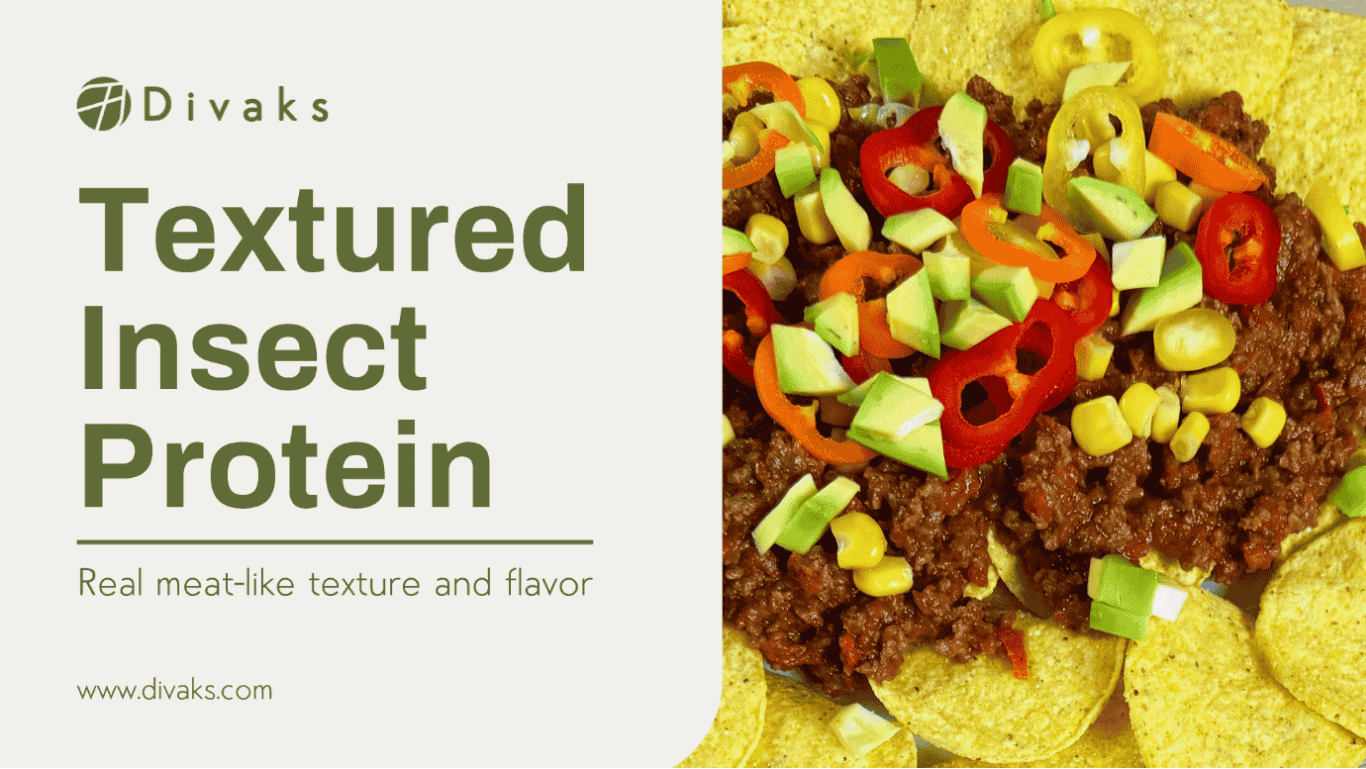
A new era of alternative protein: meet Textured Insect Protein (TIP)
With the increasing demand for sustainable and nutritious food around the world, alternative protein is more popular than ever before. Consumers and food producers alike are actively looking for high quality, organic meat alternatives to conventional meat products. Among these innovations, Textured Insect Protein (TIP) stands out as a unique combination of functionality, nutrition and sustainability. But what exactly makes TIP a unique choice in the world of alternative protein? Let’s take a closer look.
Why are consumers looking for alternative protein and meat substitutes?
Food consumption habits are changing. More and more people are looking for healthier, more sustainable alternatives to traditional meat. The growing interest in alternative protein solutions is also driven by a number of key reasons: environmental, health and ethical. Traditional livestock farming has a significant impact on the planet, and people are often turning to a substitute for meat that helps to reduce the negative impact on the environment while providing the body with all the nutrients needed.
Although plant protein foods such as soya or pea protein are also widely used, they may not always provide a complete nutritional composition. Increasing attention is turning to alternative protein sources, such as insect protein, which is not only nutritious but also sustainable.
How does Textured Insect Protein (TIP) stand out in this category? This product not only provides a complete protein profile, but also a meat-like texture, making it a potential next-generation meat substitute.
What is Textured Insect Protein (TIP)?
Meet the Textured Insect Protein (TIP), a breakthrough in the world of alternative protein, offering a unique combination of meat-like texture and flavor.
A blend of pea and insect protein, TIP is a functionald and flavourful product developed by an insect protein company Divaks. With its subtle, clean taste, it closely resembles what consumers experience when eating red meat.
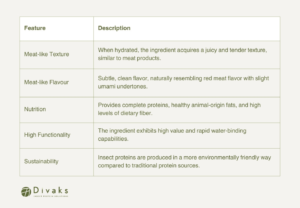
TIP is both tasty and nutritionally complete. It provides complete proteins (containing all essential amino acids), healthy fats, and high levels of dietary fiber, making it suitable for health-focused food formulations.
It also has strong water-binding capabilities, ensuring optimal moisture and texture in final formulations, even after preparation.

Power-packed nutrition with alternative protein: The benefits of TIP
TIP offers a range of nutritional benefits, making it an excellent choice for protein-rich food products.
With over 61 grams of protein per 100 grams, TIP provides all essential amino acids, which are crucial for muscle health, recovery, and overall body function.
This type of alternative protein also contains high levels of healthy unsaturated fats, which are known to benefit heart health, while keeping saturated fat and cholesterol levels low.
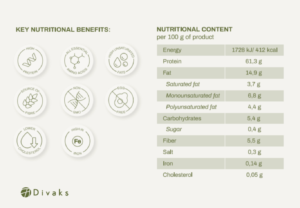
Additionally, TIP is rich in dietary fiber and iron, supporting digestive health and oxygen transport in the body.
Being naturally free from GMOs and eggs, TIP caters to a wide range of dietary needs, including those with specific dietary restrictions.
A sustainable and efficient alternative protein source
TIP is a nutritious and environmentally friendly alternative protein source that requires fewer resources compared to traditional livestock.
The primary ingredient, yellow mealworm (Tenebrio molitor), widely used by insect protein companies, generates a much lower carbon footprint compared to beef and demands substantially less land, reinforcing the potential of insects for food as a sustainable alternative in protein production. According to a study conducted by researchers from the Justus Liebig University Giessen in Germany, mealworm production emits on average 3.4 kg CO₂ per kg of protein—approximately 100 times lower than beef, a fact that has driven insect protein companies to further develop sustainable solutions. Additionally, a research funded by Wageningen University showed that beef production uses around 164 m² of land per 100 g of protein, while mealworm farming uses only 1.8 m² per kg of protein, making it a highly efficient and sustainable protein source.
How does TIP compare to other protein foods?
When choosing an alternative protein, consumers are not only looking for nutritional value. Equally important is a pleasant texture and good taste. The great news is that Textured Insect Protein (TIP) delivers on all of these aspects, while also providing more functional options than traditional protein sources.
- TIP vs. traditional substitute for meat: most meat substitutes on the market, such as soy-based products, often have a specific aftertaste or require additional additives to achieve the right consistency. TIP, as an innovative alternative protein, naturally provides a juicy, meat-like texture without intensive processing.
- TIP vs. conventional protein powder: popular protein foods such as whey protein are commonly used in sports supplements and shakes, but are not necessarily applicable to a wide range of dishes. Textured Insect Protein is a complete ingredient for a wide range of dishes, from burgers to stews, providing not only the benefits of high protein ingredients, but also a pleasant texture reminiscent of ground meat. Important for the dish you are preparing: a fine, flour-like and easy to incorporate protein source? You can always try TIP in another form – Textured Insect Protein Powder (TIPP), also produced by an insect protein company Divaks.
How TIP works: Functional properties explained
TIP owes its versatility to its high water-absorption capacity. To prepare it for cooking, TIP requires a simple hydration process to become juicy and tender.
When soaked in hot water for 30 minutes, it reaches an optimal hydration of 2.2 grams of water per gram of product.

Cold water can also be used, although it takes longer—up to 60 minutes—to absorb a comparable amount of water, around 2 grams per gram of product.
This flexibility in hydration options makes textured insect protein easy to incorporate into different recipes, catering to various preparation needs and preferences and further promoting the acceptance of insects for food in modern cuisine.
Creative ways to use TIP in your recipes
- Meat substitutes: TIP makes an excellent foundation for meat substitute products, delivering a satisfying, protein-rich alternative to traditional meat.
- With a recommended usage level of 5-30%, TIP works well in plant-based burgers, meatballs, sausages, and ground meat dishes.
- Prepared meals and dishes: In turn, this juicy meat-like texture can be used by consumers or manufacturers seeking to develop tasty internationally renowned dishes, including, burritos, stews, deli-style dishes, and more.
To give you a concrete example, here’s a recipe and cooking process for making Italian-style meatballs with Textured Insect Protein (TIP).
It’s as simple as that!
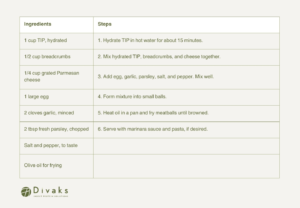
This versatility, along with other applications such as loaded nachos, makes TIP a great ingredient for high-protein options. It effectively mimics the mouthfeel and taste of animal-based products, appealing to flexitarians and those seeking meat alternatives.
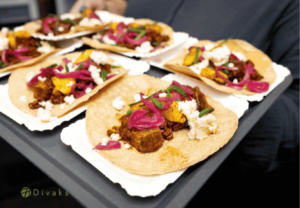
Want to learn more about TIP?
TIP is a versatile, nutritious, and sustainable alternative to traditional protein sources. It aligns with modern dietary needs, providing a high-protein, environmentally friendly option. With a wide range of applications, TIP supports a shift towards more responsible and sustainable eating practices.
Contact our sales team to receive a sample at: sales@divaks.com
You can also ask for a more detailed product sheet that includes TIP’s nutritional composition, application instructions, and functional properties.
